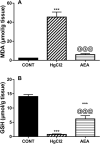Anandamide modulates WNT-5A/BCL-2, IP3/NFATc1, and HMGB1/NF-κB trajectories to protect against mercuric chloride-induced acute kidney injury
- PMID: 37488162
- PMCID: PMC10366223
- DOI: 10.1038/s41598-023-38659-9
Anandamide modulates WNT-5A/BCL-2, IP3/NFATc1, and HMGB1/NF-κB trajectories to protect against mercuric chloride-induced acute kidney injury
Abstract
Endocannabinoid anandamide (AEA) has a physiological role in regulating renal blood flow, whereas its analogs ameliorated renal ischemia/reperfusion injury. Nonetheless, the role of AEA against mercuric chloride (HgCl2)-induced renal toxicity has not been unraveled. Rats were allocated into control, HgCl2, and HgCl2/AEA treated groups. The administration of AEA quelled the HgCl2-mediated increase in inositol trisphosphate (IP3) and nuclear factor of activated T-cells cytoplasmic 1 (NFATc1). The endocannabinoid also signified its anti-inflammatory potential by turning off the inflammatory cascade evidenced by the suppression of high mobility group box protein-1 (HMGB1), receptor of glycated end products (RAGE), nuclear factor-κB p65 (NF-κB), and unexpectedly PPAR-γ. Additionally, the aptitude of AEA to inhibit malondialdehyde and boost glutathione points to its antioxidant capacity. Moreover, AEA by enhancing the depleted renal WNT-5A and reducing cystatin-C and KIM-1 (two kidney function parameters) partly verified its anti-apoptotic capacity, confirmed by inhibiting caspase-3 and increasing B-cell lymphoma-2 (BCL-2). The beneficial effect of AEA was mirrored by the improved architecture and kidney function evidenced by the reduction in cystatin-C, KIM-1, creatinine, BUN, and caspase1-induced activated IL-18. In conclusion, our results verify the reno-protective potential of AEA against HgCl2-induced kidney injury by its anti-inflammatory, antioxidant, and anti-apoptotic capacities by modulating WNT-5A/BCL-2, IP3/NFATC1, HMGB-1/RAGE/NF-κB, caspase-1/IL-18, and caspase-3/BCL-2 cues.
© 2023. The Author(s).
Conflict of interest statement
The authors declare no competing interests.
Figures







Similar articles
-
Mirabegron, dependent on β3-adrenergic receptor, alleviates mercuric chloride-induced kidney injury by reversing the impact on the inflammatory network, M1/M2 macrophages, and claudin-2.Int Immunopharmacol. 2024 Jan 5;126:111289. doi: 10.1016/j.intimp.2023.111289. Epub 2023 Nov 27. Int Immunopharmacol. 2024. PMID: 38016347
-
Azilsartan Modulates HMGB1/NF-κB/p38/ERK1/2/JNK and Apoptosis Pathways during Renal Ischemia Reperfusion Injury.Cells. 2023 Jan 2;12(1):185. doi: 10.3390/cells12010185. Cells. 2023. PMID: 36611978 Free PMC article.
-
Rutin protects mercuric chloride-induced nephrotoxicity via targeting of aquaporin 1 level, oxidative stress, apoptosis and inflammation in rats.J Trace Elem Med Biol. 2019 Jul;54:69-78. doi: 10.1016/j.jtemb.2019.04.007. Epub 2019 Apr 18. J Trace Elem Med Biol. 2019. PMID: 31109623
-
Tetramethylpyrazine guards against cisplatin-induced nephrotoxicity in rats through inhibiting HMGB1/TLR4/NF-κB and activating Nrf2 and PPAR-γ signaling pathways.Eur J Pharmacol. 2019 Aug 15;857:172422. doi: 10.1016/j.ejphar.2019.172422. Epub 2019 May 30. Eur J Pharmacol. 2019. PMID: 31152701
-
Pentoxifylline treatment alleviates kidney ischemia/reperfusion injury: Novel involvement of galectin-3 and ASK-1/JNK & ERK1/2/NF-κB/HMGB-1 trajectories.J Pharmacol Sci. 2021 Jul;146(3):136-148. doi: 10.1016/j.jphs.2021.03.011. Epub 2021 Apr 9. J Pharmacol Sci. 2021. PMID: 34030796
Cited by
-
Renal Outcomes and Other Adverse Effects of Cannabinoid Supplementation.Nutrients. 2024 Dec 27;17(1):59. doi: 10.3390/nu17010059. Nutrients. 2024. PMID: 39796493 Free PMC article. Review.
-
Anandamide Inhibits Vascular Smooth Muscle Migration, Endothelial Adhesion Protein Expression and Monocyte Adhesion of Human Coronary Artery Cells.Cells. 2024 Dec 19;13(24):2108. doi: 10.3390/cells13242108. Cells. 2024. PMID: 39768198 Free PMC article.
-
Quantitative Assessment of Intracellular Effectors and Cellular Response in RAGE Activation.Arch Intern Med Res. 2024;7(2):80-103. doi: 10.26502/aimr.0168. Epub 2024 Apr 26. Arch Intern Med Res. 2024. PMID: 38784044 Free PMC article.
-
Unlocking the therapeutic potential of the NFAT pathway in kidney diseases.Naunyn Schmiedebergs Arch Pharmacol. 2025 Aug;398(8):9873-9886. doi: 10.1007/s00210-025-04033-x. Epub 2025 Mar 15. Naunyn Schmiedebergs Arch Pharmacol. 2025. PMID: 40088333 Review.
References
-
- Zalups RK. Molecular interactions with mercury in the kidney. Pharmacol. Rev. 2000;52:113–143. - PubMed
Publication types
MeSH terms
Substances
LinkOut - more resources
Full Text Sources
Research Materials
Miscellaneous

